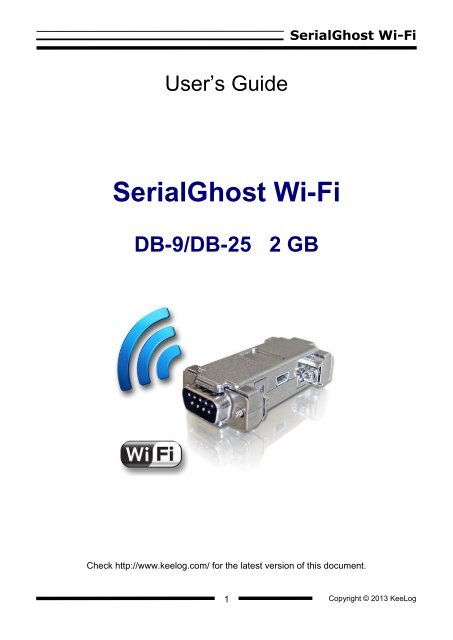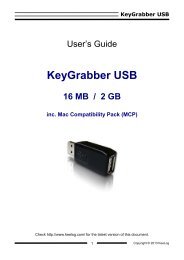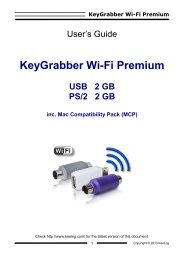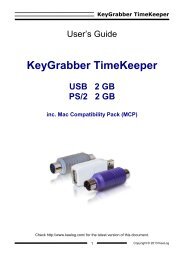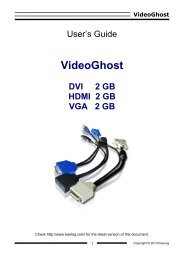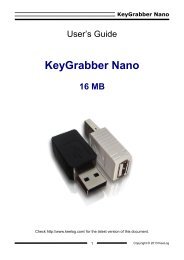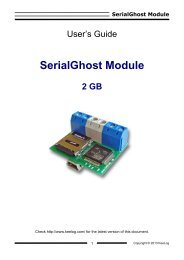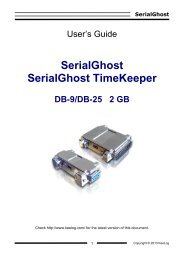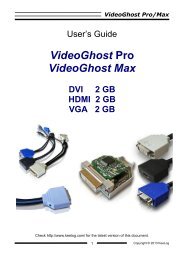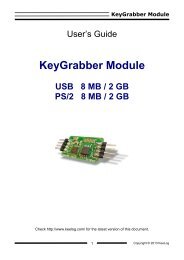Serial RS-232 Logger User Guide - SerialGhost Wi-Fi
Serial RS-232 Logger User Guide - SerialGhost Wi-Fi
Serial RS-232 Logger User Guide - SerialGhost Wi-Fi
- No tags were found...
Create successful ePaper yourself
Turn your PDF publications into a flip-book with our unique Google optimized e-Paper software.
<strong>Serial</strong>Ghost <strong>Wi</strong>-<strong>Fi</strong>Step 9. If E-mail reporting is not enough, you can take full control over the device from anycomputer in your Local Area Network. Install the supplied application KL Tools, add the loggerto the list by its IP number, and explore the available features.Using KL Tools you can communicate with multiple <strong>Serial</strong>Ghosts, allowing creating entirenetworks of wireless data loggers. This solution is particularly recommended for monitoringseveral devices in a system with a large number of devices using serial buses, such as <strong>RS</strong>-<strong>232</strong>.To read more on KL Tools, jump to section Remote access.9Copyright © 2013 KeeLog
<strong>Serial</strong>Ghost <strong>Wi</strong>-<strong>Fi</strong>TimestampInterval sets the interval of serial bus inactivity in seconds, that will trigger a newtime-stamp being logged. Range is 1 second to 9999 seconds. Default value is 10.DisableLogging allows to disable logging. Allowed values are Yes (logging disabled) and No(logging enabled). Default value is No.Encryption enables flash disk encrypting. Encryption will ensure full confidentiality of thestored data, even if the device is physically tampered with. Allowed values are Yes(encryption enabled) and No (encryption disabled). Default is No.Important: toggling the encryption setting will format the entire flash disk. All data will be lost,including the configuration file!Password sets the 3-letter password for remote access over TCP/IP (for example using KLTools). Any three-letter combination is allowed (sequence and case are irrelevant). Defaultvalue is KBS.LogMode sets the logging mode. Possible values are Ascii (data is logged as ASCII), Hex(data is logged as hexadecimal numbers), Dec (data is logged as decimal numbers). Defaultvalue is Ascii.Separator sets the separator character between data values in logging mode Dec/Hex.Possible values are None, Space, Comma, Tab, Newline. Default is Space.LogStream configures which serial stream are to be logged. Possible values are Both (bothRX and TX get logged), Rx (only Rx is logged), Tx (only Tx is logged). Default is Both. If themode is set to Both, the [1] and [2] markers will be used to differentiate between streams.A full list of parameters is available in section Configuration files.11Copyright © 2013 KeeLog
<strong>Serial</strong>Ghost <strong>Wi</strong>-<strong>Fi</strong>Recording dataRecord mode is the default mode of operation for the <strong>Serial</strong>Ghost <strong>Wi</strong>-<strong>Fi</strong> data logger. In recordmode, the device will silently monitor the bidirectional data flow on the serial bus and store thecaptured data on the internal Flash Drive in file LOG.TXT.The <strong>Serial</strong>Ghost <strong>Wi</strong>-<strong>Fi</strong> must first be configured to the appropriate serial bus parameters, suchas baud rate. Refer to section Configuration for detailed instructions.Installation of the <strong>Serial</strong>Ghost <strong>Wi</strong>-<strong>Fi</strong> in record mode is quick and easy, no software or driversare required. Simply plug it in-line on the serial bus, using the DB-9 or DB-25 connectors. Thedevice may be powered from a standard USB port, using the supplied cable. Alternatively, anexternal +5V DC (min. 200 mA) power supply may be used to power the device through themini-USB port (cell phone chargers with USB connectors are well suited for this).<strong>Serial</strong>Ghost in record mode powered from aUSB port.<strong>Serial</strong>Ghost in record mode powered by anexternal 5V DC (min. 200mA) power supply.12Copyright © 2013 KeeLog
<strong>Serial</strong>Ghost <strong>Wi</strong>-<strong>Fi</strong>Viewing recorded dataOnce serial data has been recorded, it may be retrieved on any computer with a USB port.This is done by switching to Flash Drive mode. Take the supplied USB cable and connect it tothe mini-port on the logger’s side. Connect the USB cable to a free USB port using thesupplied red USB Key.After a few seconds, the <strong>Serial</strong>Ghost <strong>Wi</strong>-<strong>Fi</strong> will automatically get detected as a mass storagedevice, and pop up as a removable drive. The operating system will use the standard built-inmass storage driver (MS <strong>Wi</strong>ndows 7 in the following examples).Depending on the drive letters available, the device will be visible as a new drive, for exampleF:. Use the systems file manager to browse this disk (for example Explorer).13Copyright © 2013 KeeLog
<strong>Serial</strong>Ghost <strong>Wi</strong>-<strong>Fi</strong>The removable disk will contain the file LOG.TXT with a text log of all captured data. The datais stored in the same format as appearing on the serial bus, without any encoding. Theupstream data (TX) and downstream data (RX) will be differentiated by the markers [1] and[2] interleaved in the log file. The <strong>Serial</strong>Ghost <strong>Wi</strong>-<strong>Fi</strong> will also interleave time-stamps. The fileLOG.TXT can be viewed and searched with any text editor, such as Notepad or MS Word.Switching back to record mode can be achieved by a safe software removal of the flash disk.Use the systems standard disk removal procedure. For MS <strong>Wi</strong>ndows, left-click on the SafeRemoval icon in the system tray and select the appropriate drive. Then reconnect the<strong>Serial</strong>Ghost to the USB port, however without the supplied USB Key.To get the most out of the <strong>Serial</strong>Ghost, install the supplied application KL Tools. Go to sectionUsing KL Tools to find out more.14Copyright © 2013 KeeLog
<strong>Serial</strong>Ghost <strong>Wi</strong>-<strong>Fi</strong>Remote accessThis section guides through enabling E-mail reporting and TCP/IP access for the <strong>Serial</strong>Ghost<strong>Wi</strong>-<strong>Fi</strong> data logger.ChecklistBefore you start, make sure you have the following data about the <strong>Wi</strong>-<strong>Fi</strong> network the loggerwill operate in:WLAN Access Point ID (SSID)WLAN encryption type (WPA-2, WPA, WEP64/128, or open network)WLAN encryption passwordMake sure you also have an E-mail address the wireless logger can send reports to. <strong>Fi</strong>nally,to make the configuration process as simple as possible, install the supplied application KLTools. The installation process is straightforward, just follow the wizard and answer a fewstandard questions.ConfigurationThe <strong>Serial</strong>Ghost <strong>Wi</strong>-<strong>Fi</strong> can be configured and operated entirely from KL Tools. Launch theapplication, select the device model, and choose to configure your device. The application willfirst display a serial bus configuration dialog, and then a time configuration dialog. If changingthe default password, memorize or note the new values, otherwise access to the internalmemory will not be possible. If unsure about a certain configuration option, leave the defaultvalue.15Copyright © 2013 KeeLog
<strong>Serial</strong>Ghost <strong>Wi</strong>-<strong>Fi</strong><strong>Serial</strong> bus configurationTime-stamping module configuration<strong>Fi</strong>nally, a <strong>Wi</strong>-<strong>Fi</strong> configuration dialog will be shown. Enterthe data allowing the logger to connect to the WLANAccess Point: WLAN Access Point ID (SSID) WLAN encryption type WLAN encryption passwordRemember, that these strings are case-sensitive.If the WLAN Access Point does not allow Auto-IPconfiguration through DHCP, provide a static IP address,network mask, gateway address, and DNS information.To receive E-mail reports containing serial data, supplyyour E-mail address. You may adjust the reporting intervaland report size.When finished, make sure the device is connected as inrecord mode. KL Tools will automatically createconfiguration files (CONFIG.TXT, TIME.TXT, WIFI.TXT),prompt for enabling Flash Drive mode, and copy the filesto the loggers Flash Drive.16Copyright © 2013 KeeLog
<strong>Serial</strong>Ghost <strong>Wi</strong>-<strong>Fi</strong>E-mail reportingThe <strong>Serial</strong>Ghost <strong>Wi</strong>-<strong>Fi</strong> will send E-mail reports to the specified recipient address, by defaultevery hour. Besides logged data, the report will contain Access Point information, IPconfiguration, and time-stamps.The report size and interval may be set by configuring the logger through the file WIFI.TXT.Use KL Tools to do this, or view section Configuration files.17Copyright © 2013 KeeLog
<strong>Serial</strong>Ghost <strong>Wi</strong>-<strong>Fi</strong>On-demand accessThe <strong>Serial</strong>Ghost <strong>Wi</strong>-<strong>Fi</strong> offers on-demand access via TCP/IP from any computer connected tothe network. This feature is usually limited to the Local Area Network, unless your localnetwork segment is visible globally. To access the logger remotely, launch KL Tools, selectthe proper device version, and navigate through the wizard to remote access. The <strong>Wi</strong>-<strong>Fi</strong>Control Center will be shown.A remote device needs to be added first. This can be done by clicking the Add Device icon,and supplying the IP address, name (optional), and device password. The password mustmatch the local 3-character combination defined in the devices CONFIG.TXT (K, B, S bydefault).The IP address of the remote device can be obtained in a few ways:from an E-mail report (see section E-mail reporting)from the device configuration (if using static IP)from the Access Point configuration (if using Auto-IP)If the IP address is unknown, the Search Local Network option can be used. This feature willsend a broadcast signal to all devices in the Local Area Network, to which remote loggers18Copyright © 2013 KeeLog
<strong>Serial</strong>Ghost <strong>Wi</strong>-<strong>Fi</strong>should respond. Make sure that no firewall blocks UDP communication, otherwise theprocedure will fail.Once a remote device is added, the log may be retrieved using the Download Log option.If interested in other parts of the remote log file than the most recent 50 kB, use the DownloadLog Chunk option. This will display a dialog, allowing downloading any part of the remote logfile.19Copyright © 2013 KeeLog
<strong>Serial</strong>Ghost <strong>Wi</strong>-<strong>Fi</strong>KL Tools offers a wide variety of options, available at a single mouse-click:E-mail and WWW searchEncoding and layout conversionDocument searchingDocument exportingCommunication with remote deviceMultiple device handlingUsing KL Tools you can communicate with multiple <strong>Serial</strong>Ghosts, allowing creating entirenetworks of wireless data loggers. This solution is particularly recommended for monitoringseveral devices in a system with a large number of devices using serial buses, such as <strong>RS</strong>-<strong>232</strong>.20Copyright © 2013 KeeLog
<strong>Serial</strong>Ghost <strong>Wi</strong>-<strong>Fi</strong>Clock configurationIt is necessary to configure the built-in clock module for getting correct date and time-stamps.This task can be performed by KL Tools (recommended), or can be done manually.To configure the internal clock using KL Tools,launch the application, select the device model,and choose to configure the device. Theapplication will display a time and dateconfiguration dialog. Make sure date and timestamping is enabled, and that the Set time anddate checkbox is clicked. Select the desiredtime format, and move to the succeedingdialogs.KL Tools will guide you through enabling FlashDrive mode, and placing the configuration fileTIME.TXT on the internal flash disk.The clock can also be configured manually, without using KL Tools. To do this, a text filenamed TIME.TXT should be prepared with the following format:Year=2010Month=4Day=1Hour=12Minute=34Second=56Format=PMThe fields should contain the current time and date. The field Format allows distinguishingbetween A.M., P.M., and 24-hour time (use the value AM, PM, or 24). After the file has beenprepared, switch to Flash Drive mode and copy the file TIME.TXT to the root folder of theflash disk. The USB Key delivered with the device has to be used to switch to Flash Drivemode.21Copyright © 2013 KeeLog
<strong>Serial</strong>Ghost <strong>Wi</strong>-<strong>Fi</strong>After copying the file, safely remove the Flash Drive. The new clock configuration will beloaded on next power-up.The clock configuration file must be named TIME.TXT and must be placed in the root folder.Variable and value strings are case insensitive, however they must match the options listedbelow. Year sets the clock year value. Valid range is from 2000 to 2099. Month sets the clock month value. Valid range is from 1 (January) to 12 (December). Day sets the clock day value. Valid range is from 1 to 31. If the specified day exceedsthe maximum number of days in the specified month, the next valid day value will bechosen. Hour sets the clock hour value. Valid range is from 1 to 12 for 12-hour time(A.M./P.M.), and 0 to 23 for 24-hour time. Minute sets the clock minute value. Valid range is from 0 to 59. Second sets the clock second value. Valid range is from 0 to 59. Format sets the time format. Valid values are AM, PM, and 24. If AM is chosen, the 12-hour format is selected and the specified hour is treated as before noon. If PM ischosen, the 12-hour format is selected and the specified hour is treated as after noon.If 24 is chosen, the 24-hour format is selected and the specified hour is treated as 24-hour format.Sample TIME.TXT for 12-hour time:Year=2010Month=10Day=25Hour=5Minute=51Second=43Format=PMSample TIME.TXT for 24-hour time:Year=2010Month=10Day=25Hour=17Minute=51Second=43Format=2422Copyright © 2013 KeeLog
<strong>Serial</strong>Ghost <strong>Wi</strong>-<strong>Fi</strong>Using KL ToolsKL Tools is a free application delivered with all <strong>Serial</strong>Ghost series devices. KL Tools assists inconfiguring a <strong>Serial</strong>Ghost and retrieving the recorded data it contains. It is not necessary tooperate the device, but may speed up usage by its intuitive user interface.KL Tools is available on the CD-ROM attached with the device. Installing KL Tools isstraightforward. Simply follow the installation wizard and answer standard questions. Wheninitialized, KL Tools will ask for the device type, and assist in configuring the device andretrieving the recorded images. There is no special knowledge required to use KL Tools –simply follow the instructions displayed by the application.23Copyright © 2013 KeeLog
<strong>Serial</strong>Ghost <strong>Wi</strong>-<strong>Fi</strong>Configuration filesThe <strong>Serial</strong>Ghost <strong>Wi</strong>-<strong>Fi</strong> is configured via three text files placed on the internal Flash Drive: CONFIG.TXT (configures serial bus parameters) TIME.TXT (configures the internal clock for time-stamping) WIFI.TXT (configures <strong>Wi</strong>-<strong>Fi</strong> functionality)These files should contain configuration parameters, placed in successive lines in thefollowing format:Parameter1=ValueParameter2=ValueParameter3=Value…Example of WIFI.TXT<strong>Wi</strong><strong>Fi</strong>Network=MyNetwork<strong>Wi</strong><strong>Fi</strong>Password=MyPassword<strong>Wi</strong><strong>Fi</strong>Encryption=WPA2Recipient=john@smith.comThese configuration files must be placed in the device internal memory using Flash Drivemode.Device configuration can be performed by KL Tools, or manually by the user. KL Toolsperforms the same operation as would be done manually, that is creates the configurationfiles, requests switching to Flash Drive mode, and copies the files to the flash disk.Creating configuration files manually may be necessary on systems not supported by KLTools, such as Mac OS or Linux.24Copyright © 2013 KeeLog
<strong>Serial</strong>Ghost <strong>Wi</strong>-<strong>Fi</strong>CONFIG.TXTThe file CONFIG.TXT is responsible for configuring serial bus parameters.Parameter Values Example DescriptionBaudrateBitsParityStopBitsTimestampingTimestampIntervalDisableLoggingEncryptionPasswordSeparatorLogModeLogStreamBaud rate in bps(default 9600)5678 (default)None (default)EvenOddSpaceMark1 (default)1.52Yes (default)NoTimestamp interval inseconds (default 10)YesNo (default)YesNo (default)3-character password(default KBS)NoneSpace (default)CommaTabNewlineAscii (default)HexDecBoth (default)RxTxBaudrate=115200Bits=7Parity=EvenParity=1Timestamping=YesTimestampInterval=1DisableLogging=YesEncryption=NoPassword=SVLSeparator=CommaLogMode=HexLogStream=Tx<strong>Serial</strong> bus baud rate in bits per second(300…115200).Number of bits per transfer on themonitored serial bus.Type of parity bit on the monitoredserial bus.Number of stop bits per transfer on themonitored serial bus.Time-stamping disable flag.Interval of bus inactivity which willresult in a time-stamp being added.Data logging disable flag.Flash drive encryption setting (caution:changing this value will re-format theflash drive).Three-character combination foraccessing the device over TCP/IP (forexample using KL Tools).The separator between data values inDec/Hex modes.Data format in log file.Selection of serial data streams to belogged.25Copyright © 2013 KeeLog
<strong>Serial</strong>Ghost <strong>Wi</strong>-<strong>Fi</strong>TIME.TXTThe file TIME.TXT is responsible for configuring the built-in real-time clock.Parameter Values Example DescriptionYearMonthDayHourMinuteSecondFormatYear value(range 2000…2099, default 2010)Month value(range 1…12, default 1)Day value(range 1…31, default 1)Hour value(range 1…12 or 0…23, default 1)Minute value(range 0…59, default 0)Second value(range 0…59, default 0)AMPM (default)24Year=2010 Year setting (range 2000 to 2099).Month=10Month setting (1 is January, 12 isDecember).Day=15 Day setting (range 1 to 31).Hour=6Hour setting (range 1 to 12 for A.M./P.M.format and 0 to 23 for 24-hour time).Minute=37 Minute setting (range 0 to 59).Second=49 Second setting (range 0 to 59).Format=24Time format setting. If AM is chosen, the12-hour format is selected and thespecified hour is treated as before noon.If PM is chosen, the 12-hour format isselected and the specified hour is treatedas after noon. If 24 is chosen, the 24-hour format is selected and the specifiedhour is treated as 24-hour format.26Copyright © 2013 KeeLog
<strong>Serial</strong>Ghost <strong>Wi</strong>-<strong>Fi</strong>WIFI.TXTThe file WIFI.TXT is responsible for configuring <strong>Wi</strong>reless LAN and TCP/IP functionality. Thefollowing tables summarize the available parameters.Basic parameter listParameter Values Example Description<strong>Wi</strong><strong>Fi</strong>Network<strong>Wi</strong><strong>Fi</strong>Encryption<strong>Wi</strong><strong>Fi</strong>PasswordIpAddressNetMaskGatewayDnsServerDnsServer2RecipientReportIntervalReportSizeDisable<strong>Wi</strong><strong>Fi</strong>SSID string (nodefault)None (default)WEP64WEP128WPAWPA2Password string(no default)IP address string(no default)Network maskstring (no default)Gateway addressstring (no default)<strong>Fi</strong>rst DNS addressstring (no default)Second DNSaddress string (nodefault)E-mail recipientstring (no default)Interval value (min.600 sec. or 3600sec., default 3600sec.)Size value (max.102400 bytes,default 10240bytes)YesNo (default)<strong>Wi</strong><strong>Fi</strong>Network=My<strong>Wi</strong><strong>Fi</strong><strong>Wi</strong><strong>Fi</strong>Encryption=WPA2<strong>Wi</strong><strong>Fi</strong>Password=MyPassIpAddress=192.168.0.100NetMask=255.255.255.0Gateway=192.168.0.1DnsServer= 216.231.41.2DnsServer2= 206.124.64.1Recipient=john@server.comReportInterval=7200ReportSize=20000Disable<strong>Wi</strong><strong>Fi</strong>=YesAccess Point ID (SSID), casesensitive.If omitted, <strong>Wi</strong>-<strong>Fi</strong>functionality will be disabled.Access Point encryption type. Ifomitted, <strong>Wi</strong>-<strong>Fi</strong> functionality willbe disabled.Access Point password, casesensitive. If open network, skipthis parameter.Static IP address of device. Skipthis parameter if using Auto-IP.Network mask of device. Skipthis parameter if using Auto-IP.Default gateway. Skip thisparameter if using Auto-IP.<strong>Fi</strong>rst DNS. Skip this parameter ifusing Auto-IP.Second DNS. Skip thisparameter if using Auto-IP.Recipient E-mail address for E-mail reporting. If omitted,reporting will be disabled.Interval for E-mail reporting inseconds. Minimum interval is600 seconds (10 minutes) forcustom SMTP server, and 3600seconds (1 hour) for defaultserver.E-mail report size in bytes.<strong>Wi</strong>-<strong>Fi</strong> disable flag.27Copyright © 2013 KeeLog
<strong>Serial</strong>Ghost <strong>Wi</strong>-<strong>Fi</strong>Advanced parameter list (use only when you know what you’re doing!)Parameter Values Example Description<strong>Wi</strong><strong>Fi</strong>StandardDisableTcpTcpPortDisableUdpUdpPortDisableSmtpCustomSmtpSmtpServerSmtp<strong>User</strong>SmtpPasswordSmtpSenderSmtpPortUS (default)CanadaEuropeSpainFranceJapanYesNo (default)Port value(0…65535, default25999)YesNo (default)Port value(0…65535, default25998)YesNo (default)YesNo (default)Server string (nodefault)<strong>User</strong> string (nodefault)Password string(no default)Sender string (nodefault)Port value(0…65535, default25)Sample <strong>Wi</strong>-<strong>Fi</strong> configuration files:<strong>Wi</strong><strong>Fi</strong>Standard=EuropeDisableTcp=YesTcpPort=12345DisableUdp=YesUdpPort=23456DisableSmtp=NoCustomSmtp=YesSmtpServer=smtp.mail.comSmtp<strong>User</strong>=JohnSmtpPassword=MyPassSmtpSender=John SmithSmtpPort=25Standard for <strong>Wi</strong>-<strong>Fi</strong> operation.Select the region that fits best.TCP disable flag. Disables ondemandaccess through TCP/IP.TCP communication port. Mustmatch setting in KL Tools.UDP disable flag. Disablesanswering to broadcastednetwork searches.UDP communication port. Mustmatch setting in KL Tools.SMTP disable flag. Disables E-mail reporting.Custom SMTP flag. Enables userdefined SMTP server.Custom SMTP server. Definesuser SMTP server address.Custom SMTP user. Defines userSMTP user name.Custom SMTP password. Definesuser SMTP password.Custom SMTP server. Definesuser SMTP sender string.Custom SMTP communicationport.No encryption, Auto-IPWPA-2 encryption, static IP<strong>Wi</strong><strong>Fi</strong>Network=My<strong>Wi</strong><strong>Fi</strong>Recipient=john@server.com<strong>Wi</strong><strong>Fi</strong>Network=MyNetwork<strong>Wi</strong><strong>Fi</strong>Password=MyPassword<strong>Wi</strong><strong>Fi</strong>Encryption=WPA2IpAddress=192.168.0.100NetMask=255.255.255.0Gateway=192.168.0.1DnsServer= 216.231.41.2DnsServer2= 206.124.64.1Recipient=john@smith.com28Copyright © 2013 KeeLog
<strong>Serial</strong>Ghost <strong>Wi</strong>-<strong>Fi</strong>SpecificationsPower supply4.5 V – 5.5 V DCMax. power consumption 220 mA (1.1 W)Maximum continuous log speed(approx.)Memory capacityData retentionDevice supportMaximum log read speedAccess Point supportWLAN encryption support15 kB/s (both streams)2 GB100 yearsAsynchronous serial devices operating at <strong>RS</strong>-<strong>232</strong>logic levels (+/-12V)150 kB/s<strong>Wi</strong>-<strong>Fi</strong> CERTIFIED devicesWPA-2, WPA, WEP64, WEP128WLAN range 150 m (165 yards) in open terrain, approx. 50 m (55yards) through one concrete wallDimensions includingconnectors (L x W x H)DB-9 versionDB-25 version62 mm x 31 mm x 16 mm(2.4" x 1.2" x 0.6")62 mm x 54 mm x 16 mm(2.4" x 2.1" x 0.6")All KeeLog products come with 1 year warranty against manufacturer defects. Defectproducts must be shipped by the customer. All warranty repairs and delivery to the customerwill be paid by the manufacturer.29Copyright © 2013 KeeLog
<strong>Serial</strong>Ghost <strong>Wi</strong>-<strong>Fi</strong>TroubleshootingThe <strong>Serial</strong>Ghost will not work with the following hardware configurations:1. Synchronous serial buses2. Devices operating at speeds higher than 115,200 bps3. <strong>Serial</strong> buses using logic levels different than +/-12V4. <strong>Serial</strong> devices using non-standard DB-9 or DB-25 pinouts5. SPI, I2C, TWI, USB, PS/2, SATA, <strong>Fi</strong>re<strong>Wi</strong>re, etc. buses6. Non <strong>Wi</strong>-<strong>Fi</strong>-conformant Access Points (<strong>Wi</strong>-<strong>Fi</strong> CERTIFIED)The <strong>Serial</strong>Ghost does not switch to Flash Drive modePlease check the following:1. Are you using the delivered USB Key to connect the device to a USB port?2. Does the operating system support removable USB flash disks?3. Have you checked the drive list?4. Have you tried on a different USB port?5. Have you checked on a different computer?I can’t find any data after switching to Flash Drive modePlease check the following:1. Have you powered the device from the USB port while recording?2. Did you properly configure the device through CONFIG.TXT?3. Have you actually transmitted any data over the serial bus while recording?The <strong>Serial</strong>Ghost always shows up as a removable driveConnect the USB plug directly to a USB port, without the USB Key.I’m not receiving E-mail reportsPlease check the following:1. Have you configured <strong>Wi</strong>-<strong>Fi</strong> access by using KL Tools or creating WIFI.TXT manually?2. Have you provided a valid recipient E-mail address? Are you checking the recipientmailbox?3. Is the Access Point ID (SSID) set correctly? Remember, that it is case-sensitive.4. Have you configured the encryption type and password correctly (case-sensitive)?5. Is the remote device within WLAN range? Is the signal strong enough? Please verifythis by using a second WLAN device located in the same position.6. Does the Access Point configuration allow Auto-IP? If not, please provide a static IPconfiguration.30Copyright © 2013 KeeLog
<strong>Serial</strong>Ghost <strong>Wi</strong>-<strong>Fi</strong>I cannot retrieve the log using KL ToolsPlease check the following:1. Have you added the remote device to the device list in KL Tools by providing its IPaddress?2. Has the remote device established a connection to the Access Point? Check if you arereceiving E-mail reports.3. Have you performed a communication test? Right-click on the device in KL Tools andselect Test Communication.4. Have you performed a network search? Run a network search from KL Tools.5. Is a firewall blocking communication? Check if the TCP and UDP ports (default 25999and 25998) are available for communication.6. Have you provided the correct 3-character combination? The remote deviceconfiguration must match the data entered in KL Tools (default values are KBS orKBD).7. Is the remote device located in the same LAN segment as the host computer? If not,TCP/IP communication will not work.Problems with time-stampsSet the correct time by creating a clock configuration file TIME.TXT. Make sure you have notdisabled time-stamping. Refer to the Clock configuration section for detailed instructions.Can I run KL Tools on Mac OS or Linux?KL Tools is currently only available for MS <strong>Wi</strong>ndows. For configuring the device under MacOS or Linux, the configuration files CONFIG.TXT, WIFI.TXT, and TIME.TXT must be createdmanually, using a text editor.I’ve checked everything, nothing helps!If you are still experiencing problems, please do the following:1. Check if the problem appears with a different baud rate and serial bus configuration.2. Check if the problem appears with a different serial bus driver.3. Check if the problem appears using a different USB port.4. Contact the dealer you have purchased the device from. Please supply all necessaryinformation (hardware type, model and manufacturer, OS type and version, and a shortdescription of the problem).31Copyright © 2013 KeeLog
<strong>Serial</strong>Ghost <strong>Wi</strong>-<strong>Fi</strong>Legal disclaimerKeeLog does not take responsibility for any damage, harm or legal actions caused by misuseof its products. The user should follow the guidelines contained in this document, otherwiseno liability will be assumed. It is the user's responsibility to obey all effective laws in his/hercountry, which may prohibit usage of KeeLog products. Please also consider, that notknowing the law does not allow to not obeying it. A good example is the U.S. Department ofJustice Letter on Keystroke Monitoring and Login Banners, according to which a clear noticeshould be displayed, warning that user keystrokes may be logged. Please check with yourlegal representative for logging requirements in your country.For more information on KeeLog products,visit our website:http://www.keelog.com/You should not use this device to interceptdata you are not authorized to possess,especially passwords, banking data,confidential correspondence etc. Mostcountries recognize this as a crime. Pleaseconsult a legal representative for loggingrequirements in your country.32Copyright © 2013 KeeLog
<strong>Serial</strong>Ghost <strong>Wi</strong>-<strong>Fi</strong>Notes:European OfficeKeeLogLekcyjna 42PL 51-169 WroclawPolandU.S. OfficeAqua Electronics1550 Louis Ave.Elk Grove Village, IL. 60007U.S.Ahttp://www.keelog.com/keelog@keelog.comCopyright © 2004-2013. All rights reserved.RoHS33Copyright © 2013 KeeLog


